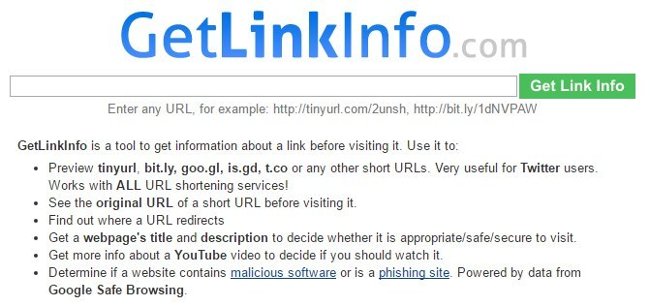Hazards from shortened links and prevention
Shortened link is a great tool. Sometimes we get into trouble with long URLs and want it to look more neat when linking it in a professional situation or when social media limits the use of characters. The purpose of the shortened link is to make it easier to use the Internet, but you know its dangers and how to fix it.
Take advantage of shortened links
One of the ways used to distribute malicious software is through links. We see links everywhere throughout the process of using the Internet, not only on websites but also in social media sources. Every day, all files are distributed as links so they take advantage of this to distribute malware. More specifically, when users click on the link, they will redirect to harmful files and websites. You might think that it is a normal website, but for anyone who knows the URL to the .exe file, it will never click on it.
Therefore, the trick used here is to hide the URL under the radar. From the link posted in the busy environment and the lack of vigilance, hackers will try to attack a few things to infiltrate the account and send a link to friends to strike the trust of everyone, even The fake URL is completely different from the actual link. Furthermore, this trick is carried out by a shortened link that conceals the true nature of the link.
Harm of shortened link
For example, we take harmless goals - Google. This is the URL of the website.
https://www.google.com
This is the Google logo that looks like in a hot link:
https://www.google.com/images/branding/googlelogo/1x/googlelogo_color_272x92dp.png
Can you see the difference between these two links? One is the website, and the other is the image file. Just read the URL, you can know the exact destination and what will appear. But instead use the Bit.ly link and compare the results. The difference is:
http://bit.ly/1dNVPAW link to https://www.google.com
And http://bit.ly/1JcI49O associated with
https://www.google.com/images/branding/googlelogo/1x/googlelogo_color_272x92dp.png
Nothing else? The only change is the mess between numbers and letters after bit.ly. We cannot see file extensions or even hide the link destination. From there, we cannot see the actual link containing the destination to Google and the logo. It's bad to know that these bit.ly links will lead to Google, and the Google logo or any other address.
That is what attackers can exploit to distribute their website software or malicious code. They may display a shortened link and confirm that it is a shocking video or article and no one can know behind which leads to a malicious file or website.
How to discover
Because they are shortened links that are spread where you cannot confirm whether they will lead to the official website, and if there is trouble clicking on it. How can I check the link without clicking on it to make sure they are not malicious?
Fortunately, there are several web services that are set up to support against attacks. Below are a few examples:

CheckShortURL is a great tool that contains many link shorteners currently in use. Enter the shortened link, CheckShortURL will analyze and indicate the website address will lead to. It allows viewing photos of the site to check its legitimacy if you are unsure about the security, and it includes links that automatically search the site on security consulting services such as the Web. of Trust.

GetLinkInfo is relatively good if you want to see the exact link that will be redirected. Short link works by redirecting users to the specified location. GetLinkInfo scans the navigation process created when you click the link. Therefore, it also said safety measures to visit using Google's secure browser advice.
In addition, some link companies shorten the consequences of transition links. Therefore, a few companies have provided special methods to check links created by its website to avoid risks. For example, do you know that if you add "+" at the end of the bit.ly link, it will lead you to a preview site, where you can check the destination before you visit. You can try with the example links above, as follows: http://bit.ly/1dNVPAW+
With shortened links used to spread malware, you should be cautious when clicking unknown links from strangers. Now you understand how the shortened link works and how to check if the link is valid or not.
You should read it
- Ignore ads of shortened links to directly access the original link on Chrome, Coc Coc and Firefox
- How to create advertising content in shared links
- Instructions for shortening quick links on Elbo.in
- Goo.gl shortener has been officially declared dead
- How to use Link Fox to shorten the website link
- How to shorten links on iPhone with Siri Shortcuts
- How to register to make money shortened link with Vinaurl
- How to shorten the link and create a QR code using goo.gl
- How to shorten links quickly - Top 5 free link shortening websites are used the most today
- Short link guide on UrlHum
- How to shorten the link on Bit.ly to make money
- Check and detect broken links on any website
May be interested

How to recover Windows passwords using iSeePassword

How many types of malware do you know and how to prevent them?

Download the free WannaCry malware checker now

Steps to remove malware 9o0gle. com

Remove the root of Search navigation. myprivacyswitch. com on the browser

How to remove fake popup window 'Update Flash Player' or 'Update Java'?






 Ignore ads of shortened links to directly access the original link on Chrome, Coc Coc and Firefox
Ignore ads of shortened links to directly access the original link on Chrome, Coc Coc and Firefox How to create advertising content in shared links
How to create advertising content in shared links Goo.gl shortener has been officially declared dead
Goo.gl shortener has been officially declared dead Instructions for shortening quick links on Elbo.in
Instructions for shortening quick links on Elbo.in How to shorten links on iPhone with Siri Shortcuts
How to shorten links on iPhone with Siri Shortcuts How to use Link Fox to shorten the website link
How to use Link Fox to shorten the website link